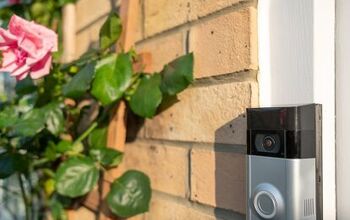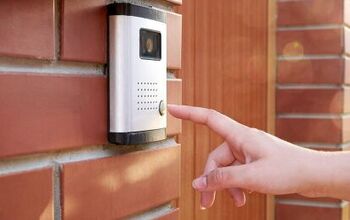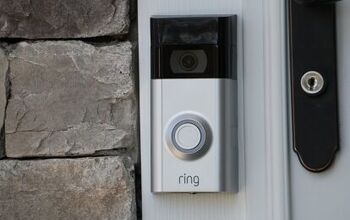Is Your Ring Doorbell Not Charging? (Possible Causes & Fixes)

All Ring doorbells, except for the Ring Doorbell Pro and the Ring Doorbell Elite, run on batteries, even if they are hardwired to the home. The battery is a rechargeable lithium-ion pack that charges via a USB cable. The battery charge should last an average of 6 to 12 months, but frequent use discharges them sooner.
A Ring doorbell that will not charge may need a new battery pack. Lithium-ion batteries have a lifespan of 2-3 years in normal use conditions. Freezing weather decreases the battery lifespan, and at -5 degrees F, it will stop working. Frequent use discharges batteries faster than they can recharge. This can be fixed by decreasing motion alert sensitivity and frequency.
There are several reasons why the Ring doorbell may not take a charge or may appear to be discharging at a faster rate than expected. This has to do with the way that the unit is designed for “normal use” conditions and the variations that users experience in real-life situations.
Do You Need a Smart Home System Installation or Service?
Get free, zero-commitment quotes from pro contractors near you.

What the Battery Pack Does
Except for the Ring Doorbell Pro and the Ring Doorbell Elite, every Ring doorbell has a battery pack. This includes all wired versions. This design is the way that Ring engineers came up with to keep the doorbell charged without users having to unmount and charge the unit, leaving the doorbell useless during the charging period.
- The battery pack is responsible for powering all of the doorbell’s functions. This ensures that the doorbell is functional even during a power outage.
- The battery pack is trickle-charged through the connection to the home’s low-voltage doorbell wires.
- When the battery pack needs additional charging it can be uninstalled and charged through the USB port.
- Charging takes five to 10 hours depending on whether the cable is plugged into a USB outlet or a regular outlet charging brick.
When the battery pack is near end-of-life it will not take as much charge as it does when it is new. A typical lithium-ion battery can take around 500 charge cycles. Additionally, lithium-ion batteries degrade over time. They lose efficiency and the amount of electricity that they can store. This means that the older a Ring doorbell gets, it will need more frequent recharging and the charging time will be longer.
Those who have a first or second-generation Ring doorbell will have to dismount and charge the unit as a whole. Subsequent versions have a pop-out battery that is located under the cover. Replacement batteries can be purchased and used to keep the unit functional while the discharged battery pack is being recharged.
Ring Doorbell Normal Use Conditions
Ring has engineered the doorbell for a “normal use” lifecycle which may not match up to a user’s real-life experience. There is a very wide variation in the performance that users experience from their Ring doorbells. In addition to frequent battery discharge events, local weather greatly affects the battery efficiency, function, and lifespan.
- The doorbell does not begin trickle charging until it drops to 90% of battery capacity. Those who monitor battery life through the device health portal on the app may see that the battery is never quite fully charged. This is normal for the Ring doorbell and does not indicate that the battery is malfunctioning or not taking a charge.
- The Ring doorbell battery is designed to last for 1,000 “events” under normal use and weather circumstances. An event is a trigger that causes internal components to wake up and begin functioning.
- Users who have the doorbell in a very busy area where it is detecting high outdoor traffic will experience rapid battery drain due to the frequency of doorbell camera and sensor activation. This can give the impression that the batteries are not charging, but it is a result of frequent battery discharge.
- Frequent use may outpace trickle charging on wired systems, giving frequent low battery alerts via app and email. This can be resolved by turning down the frequency of alerts and lowering the sensitivity settings so that the doorbell is not activated as frequently. This will allow trickle-charging to keep up with usage.
Frequent usage causes batteries to discharge faster than they can be recharged. Often Ring owners do not realize how many times the batteries are being activated and used. This is especially the case when it is taking frequent video feeds due to foot traffic outside the home, or if the doorbell is being used for a commercial application with people coming and going all day.
Frequent usage and charging will cause the battery life to degrade faster than the typical three-year lifespan. If the unit has been hard-reset and is not being used in an extremely cold environment, it is likely time to replace the battery pack.
Ring Doorbell Will Not Recharge In Extreme Cold
The Ring doorbell is engineered to function well in normal environments, but not all Ring doorbells are installed in normal environments. When the doorbell is installed in areas where the temperatures regularly drop below freezing, the performance of the unit degrades because of the limitations of the batteries.
- The Ring doorbell can be used to -5 degrees. However, at only 36-degrees F, battery charging capacity is affected.
- Lithium-ion batteries have trouble charging at 32-degrees F and may stop working altogether at -5-degrees F.
- In the case of cold weather, the doorbell’s battery will not take a charge until it warms up sufficiently. Even when it is receiving a trickle charge, it may not retain the charge because the unit is too cold.
- When frequent use is combined with cold weather, the Ring doorbell will have trouble with charging and maintaining battery life. In this case, users may receive frequent low-battery warnings.
Generation one and two owners find this most frustrating because the unit has to be unmounted and brought inside for USB charging. Subsequent models can be opened up and a fully-charged replacement battery pack can be inserted to keep the unit up and running while the original battery pack is recharged.
Ring doorbells that are mounted in cold climates will need to have backup battery packs that are swapped out more often. This is because the pack will not perform up to the official Ring standards until the weather warms up to a balmy 36-degrees F or higher. If the weather simply dips down off and on then users will not likely notice a degradation in performance.
Ring Doorbell Batteries Need Good WiFi
The Ring doorbell unit needs a very good WiFi connection to work. A weak WiFi signal can cause sensor and camera malfunctions. It can also cause the battery to drain much more quickly than it should, which will cause the trickle-charging to fall behind, and give the impression of a malfunctioning battery pack.
- If the Ring doorbell does not have a strong WiFi signal, it will need to cast around for a good signal every time it is activated. This causes a much higher battery use than it would if the signal was strong.
- The addition of a WiFi booster or simply moving the router closer to the location of the doorbell may solve charging issues. This will decrease battery drain and allow the trickle-charging to keep the batteries charged.
- For first and second-generation doorbells, the unit will need to be manually recharged after the WiFi is moved and then monitored to see if moving the WiFi signal solves the problem.
Users can try to combine a hard reset with moving the WiFi signal. This will help to reset the connections and maximize efficiency changes. When the battery is being drained too much, it also helps to turn down the frequency of notifications so that it is not coming on as often.
Ring Doorbell Will Not Charge
When the Ring doorbell will not accept a charge it is likely time to purchase a new battery pack. For first and second-generation doorbells, it is time to buy a new Ring doorbell. Users can contact Ring customer support, but the Ring company does not offer tips for units that will not take a charge.
- For units that seem to charge but continually give low-battery alerts, this is likely because the lifespan of the battery is nearing the end. Lithium-ion batteries will take less and less charge as they age, resulting in a lower capacity.
- Sometimes the unit will be charged but the app will say that the battery is low. In this case, push the doorbell a couple of times which will activate push notifications and update the app to the status of the doorbell. This should also update the Device Health status and give a more accurate battery reading.
- Always attempt a hard reset and also uninstall and reinstall the app and log back in before assuming that the unit is dead. A hard reset is accomplished by opening the cover and pressing the orange button on the inside for at least 15 seconds. This will cause the unit to reboot and may solve low-battery alert issues.
Replacement battery packs are quite affordable both from Ring and from off-brand sellers. Replacing the battery pack with a new one should solve the charging problem for good. It is a good idea to have a spare battery pack on hand to keep the unit functional at all times.
Do You Need a Smart Home System Installation or Service?
Get free, zero-commitment quotes from pro contractors near you.

Conclusion
The lithium-ion battery pack in the Ring doorbell may reject charging when the temperature is freezing. In this case, it should resume charging when the temperature has resumed sufficiently.
If the unit rejects charging and the temperature is in a normal range, then it is likely time to buy a new battery pack for the unit or replace the unit if the battery is not removable.

Hannah DeMoss has been a writer for nearly a decade. Her passion for writing began years ago has continued to grow. Her expertise at home involves furniture restoration and other small DIY tasks. When not writing, Hannah enjoys the outdoors with her husband and pups, as well as traveling.
More by Hannah DeMoss



























